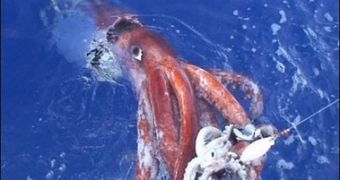Squids and their relatives, cuttlefish and octopuses, have the most complex eyes in the invertebrate world, closely resembling in structure the eyes of vertebrates. On top of that, the eyes of these animals are relatively large compared to their size.
These things considered, it's no wonder that the examination that started last week, of the largest colossal squid ever caught (and largest invertebrate ever captured) has revealed the largest eye on Earth. The 1,089-pound (490 kg), 26-ft (8.6 m) long colossal squid had been captured accidentally in February 2007 by a New Zealand fishing crew off the coast of Antarctica (in the northern Ross Sea), that was out fishing Patagonian toothfish (Chilean sea bass).
The eye of the beast was measured at about 11 in (28 cm), larger than a dinner plate and by far the largest animal eye on Earth. Blue whales, the largest living animals (up to 33 m (110 ft) long and 180 tonnes heavy), have eyes the size of those of a cow. The eye lens of the colossal squid is as big as an orange and it was found intact in one of the eyes.
"This is the only intact eye [of a colossal squid] that's ever been found. It's spectacular. It's the largest known eye in the animal kingdom," co-researcher Kat Bolstad, a squid specialist at the Auckland University of Technology told the Associated Press. "This is the largest eye ever recorded in history and studied. It has a huge lens the size of an orange and captures an awful lot of light in the dark depths in which it hunts." said Eric Warrant of Sweden's University of Lund, who specializes in vision in invertebrates.
The colossal squid, Mesonychoteuthis hamiltoni, is the largest invertebrate ever and the most mysterious of the huge squids, growing up to be 46 ft (15.3 m) long. It usually roams to depths of 6,500 ft (2,160 m) into the ocean and is believed to be an aggressive predator. The species was first detected in 1925, in the form of two tentacles spat out by a sperm whale. The meat of the enormous beast has an ammonia-like scent (resembling urine).
Colossal squid is found in Antarctic waters. Still, the most known of the huge squids is the giant squid (Architeuthis dux), which can reach 39 ft (13 m) in length, but is much less massive. It is the main object of the observations on huge squids and on the battles with sperm whales, as it populates temperate waters around the world.

 14 DAY TRIAL //
14 DAY TRIAL //